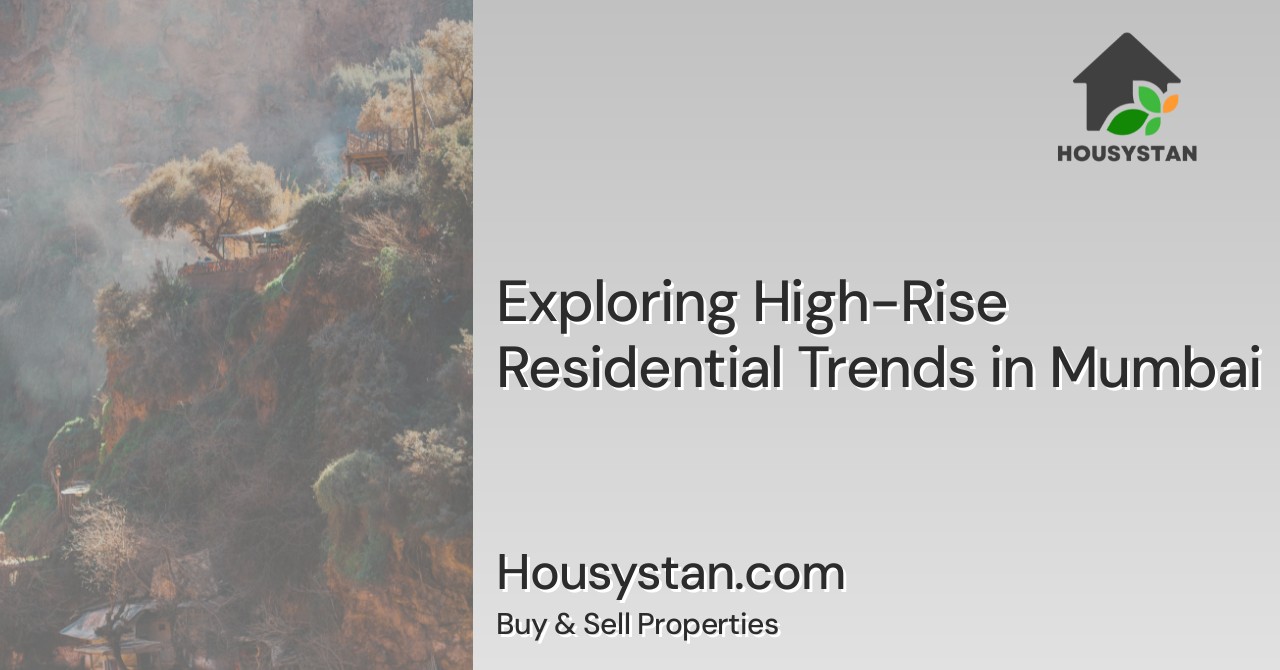Exploring High-Rise Residential Trends in Mumbai
Read latest blogs and articles from Housystan

The Information mentioned here was last updated on:
4/1/2026Exploring High-Rise Residential Trends in Mumbai
Mumbai, often called the "City of Dreams," is not only India’s financial hub but also an architectural marvel in its own right. As the city continues to grow, so does its skyline, with high-rise residential buildings becoming a financial and practical solution to accommodate its ever-increasing population. Let's delve into the recent trends in Mumbai's high-rise residential spaces, exploring their implications on urban living and the factors driving this vertical growth.
The Rise of the High-Rise: Understanding the Trend
- Verified Tenants/Buyers
- Unlimited Property Listing
- Zero subscription/charges fee
Mumbai's geographical constraints, surrounded by the Arabian Sea on three sides, make horizontal expansion almost impossible. This limitation has naturally led to vertical growth, making high-rise buildings an essential part of the city's real estate landscape. With space at a premium, these structures offer a viable solution to Mumbai’s housing crunch.
High-rise residential buildings in Mumbai are not just about accommodating more people; they represent a shift in lifestyle aspirations among city dwellers. As more individuals and families seek the comfort and luxury associated with these towering homes, developers have stepped up, aiming to meet these expectations complete with modern amenities and stunning views of the cityscape.
Amenities That Elevate Urban Living
Today’s high-rise apartments go beyond traditional expectations, often equipped with state-of-the-art facilities that redefine modern living. From swimming pools, gymnasiums, and landscaped gardens to 24/7 security and concierge services, these amenities are designed to enhance comfort and convenience for residents.
In addition to standard features, many residential towers incorporate eco-friendly designs, rainwater harvesting systems, and energy-efficient building materials. This focus on sustainability not only addresses environmental concerns but also appeals to the growing number of eco-conscious buyers.
The Role of Technology in High-Rise Developments
Advancements in construction technology play a crucial role in shaping Mumbai's high-rises. Innovative building techniques, such as prefabricated building components and high-strength concrete, enable faster construction cycles and sturdier structures.
Technology also integrates into the daily lives of residents through smart home systems that offer everything from automated lighting and temperature control to enhanced security features. These technological advancements cater to the tech-savvy population, providing efficiency and ease in managing their homes.
Location, Location, Location: Picking the Right Spot
The location of a high-rise building significantly influences its desirability and market value. Areas like South Mumbai, Bandra, and Worli are traditionally sought-after for their proximity to commercial hubs and entertainment avenues. However, newer regions like Powai and Thane are gaining popularity due to their strategic locations and improving infrastructure.
Developers are increasingly focusing on connectivity and accessibility by choosing sites near major roads, metro lines, and business districts. Proximity to schools, hospitals, and retail centers also adds to the appeal, reflecting the growing preference for integrated communities that reduce commute times and enhance quality of life.
Challenges and Considerations in High-Rise Living
While high-rise living offers numerous benefits, it also presents certain challenges. The cost associated with purchasing or renting an apartment in these buildings can be prohibitively high, restricting accessibility for a significant portion of the population. Additionally, the increased density can strain local resources and infrastructure, leading to congestion and potential service disruptions.
Safety is another critical consideration. High-rises must adhere to stringent building codes and safety standards to withstand potential threats like earthquakes and fires. Regular maintenance and updates to safety systems are crucial, necessitating active management to ensure that high safety standards are consistently met.
The Impact on Community and Urban Identity
High-rise developments are not just reshaping the physical landscape of Mumbai; they are also influencing its social fabric. As more people reside in vertical communities, interactions within neighborhoods are changing. The shared amenities in high-rise buildings encourage a sense of community, enabling residents to connect over common interests.
However, some critics argue that high-rises can lead to a loss of cultural identity and social disconnection. Different socioeconomic groups might find themselves concentrated in distinctly different types of living spaces, which can affect social integration and cohesion. Balancing modernity with Mumbai's rich cultural heritage remains a critical challenge for city planners.
Future Directions: What Lies Ahead for Mumbai’s Skyline
The future of high-rise residential living in Mumbai is poised for continued evolution. The city is expected to see more mixed-use developments that integrate residential, commercial, and recreational spaces, creating vibrant urban nodes. This model promotes a live-work-play environment, reducing the need for long commutes and fostering sustainable urban growth.
Policy changes and urban planning initiatives will also play a vital role in shaping this future. Government incentives for sustainable building practices and affordable housing initiatives will be key in making high-rise living accessible to a broader section of the population.
Technological innovations will likely continue to transform the landscape, with potential advancements in construction materials and smart infrastructure providing more efficient and resilient building solutions.
With these ongoing developments, Mumbai’s skyline will undoubtedly continue to reach new heights, reflecting the city's spirit of resilience and adaptation to the challenges of urbanization.
In summary, exploring high-rise residential trends in Mumbai offers a glimpse into the complex interplay of technology, design, and community that defines urban living today. Each aspect is part of a broader narrative of growth and adaptation in one of the world’s most dynamic cities.